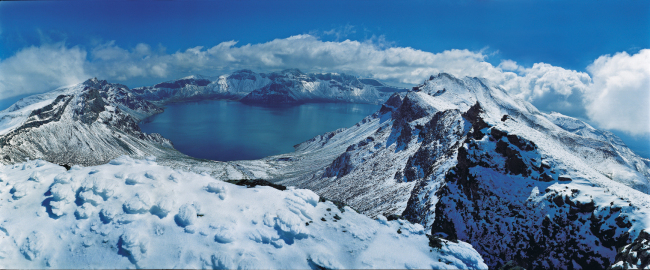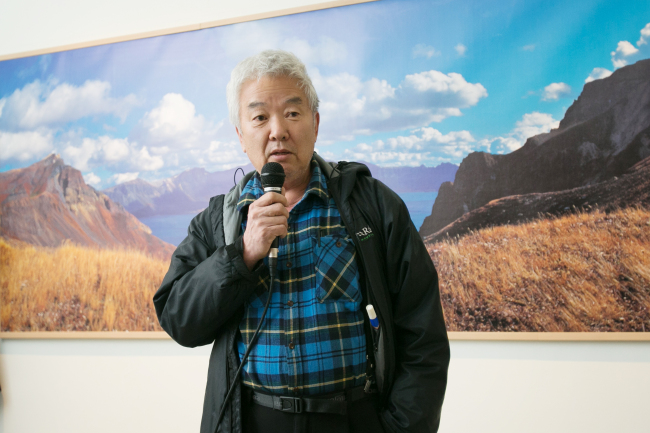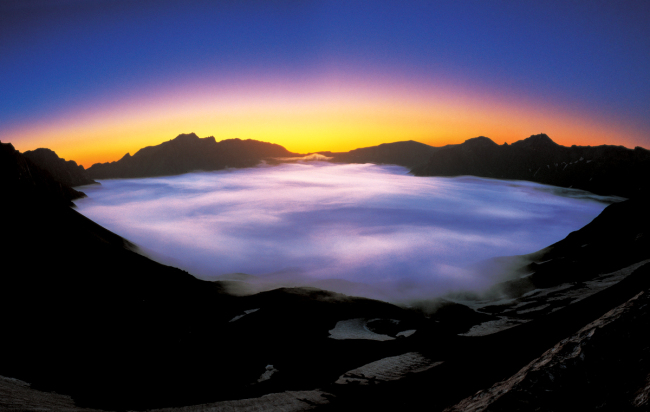Life devoted to photographing Mount Baekdusan
Ahn Seung-il exhibition to look at 20 years of work on peninsula’s highest peak
By Lee Woo-youngPublished : Jan. 28, 2014 - 19:28

Mountain photographer Ahn Seung-il has always believed Mount Baekdusan holds the soul of Korean people. The mountain, straddling North Korea and China, is the starting point of the backbone of the Korean mountains. It has been regarded as a sacred place for many Koreans as legends surrounding national foundation originate from the mountain and the surrounding area.
Ahn also believes he deserves the rank of best photographer when it comes to the mountain.
With many years of experience photographing mountains in South Korea, he ventured up Mount Baekdusan 20 years ago.
Gazing from the peak of the mountain on its Chinese side, he imagined entering the North Korean side, which was inaccessible to him. In 1995, he summoned the courage to set foot on the forbidden side. He wrote a letter to then-North Korean leader Kim Il-sung, grandfather of current leader Kim Jong-un, asking for an invitation to the North Korean area of the mountain.
“I didn’t like the situation when foreign photographers got passes to enter North Korea to photograph Mount Baekdusan while South Koreans were barred from going in there,” Ahn said in an interview with The Korea Herald at a solo exhibition of his Baekdusan photos in Seoul on Friday.

He wrote in the letter: “Dear Brother Kim Il-sung. If you need photos of Mount Baekdusan, don’t let Japanese or foreigners take pictures. Let me do so. Photos are not something done only with photography skills. They should contain the soul (of the object). It should have the pulse of the Korean nation.”
He delivered the letter to the North Korean Embassy in China.
He managed to display his Mount Baekdusan photographs to North Koreans twice through exhibitions held along with photographs taken by North Korean and Japanese photographers in Pyongyang, the North Korean capital.
“When political exchanges were almost non-existent, we had a few in the field of photography,” he said.
Since last week, Ahn has exhibited the entire collection of photographs he has taken over 20 years on Mount Baekdusan. The exhibition features some 140 photographs, including those that have been on view in North Korea.
Asked if that’s all he took for two decades, he said: “If you get five shots a year, you’ve done your best at the whims of the weather.” Ahn’s spectacular mountain photographs were the results of good weather and light, as well as patience. He spent eight months on the mountain alone and the rest of the four months with his family in Seoul.
But he wasn’t always lucky. One time, he spent 20 days waiting in a tent in harsh cold weather. But he descended without a single shot.
“I had to wait for the right moment to come. A good picture requires being in the right place at the right time,” he said.

In order to take the special shot, Ahn needed to discover new spots and gain permission to access those spots. Many of the areas on Mount Baekdusan are banned due to safety and conservation concerns.
What Ahn did to get access to the areas was to build relationships with the Chinese mountain staff ― so-called “guanxi” in Chinese ― regarded as the most important factor in doing business in China. Although it had been time-consuming, the personal network he established took him to unexplored areas, which helped him reveal unknown scenes of Mount Baekdusan.
He took various shots of the famous Cheonji Lake from points on the surrounding peaks. The photos he got were far from the conventional frontal shots of the lake taken on a clear day.
His photo images are printed on large canvases for the exhibition. One photo is printed on a canvas whose length takes up the entire two stories of the exhibition hall. Ahn believed a big canvas could deliver the feeling he had when he encountered the scene.
“On other mountains, when the clouds and fog clear, you start to shoot immediately. But not on Mount Baekdusan. Here you forget to press the shutter release. It’s that breathtaking,” Ahn said.
The exhibition continues through Feb. 18 at Ara Art Center in Insa-dong, Jongno, Seoul. For more information, call (02) 733-1981, or visit www.araart.co.kr.
By Lee Woo-young (wylee@heraldcorp.com)



![[AtoZ into Korean mind] Humor in Korea: Navigating the line between what's funny and not](http://res.heraldm.com/phpwas/restmb_idxmake.php?idx=644&simg=/content/image/2024/04/22/20240422050642_0.jpg&u=)
![[Exclusive] Korean military set to ban iPhones over 'security' concerns](http://res.heraldm.com/phpwas/restmb_idxmake.php?idx=644&simg=/content/image/2024/04/23/20240423050599_0.jpg&u=20240423183955)



![[Graphic News] 77% of young Koreans still financially dependent](http://res.heraldm.com/phpwas/restmb_idxmake.php?idx=644&simg=/content/image/2024/04/22/20240422050762_0.gif&u=)
![[Herald Interview] Why Toss invited hackers to penetrate its system](http://res.heraldm.com/phpwas/restmb_idxmake.php?idx=644&simg=/content/image/2024/04/22/20240422050569_0.jpg&u=20240422150649)





![[Exclusive] Korean military to ban iPhones over security issues](http://res.heraldm.com/phpwas/restmb_idxmake.php?idx=652&simg=/content/image/2024/04/23/20240423050599_0.jpg&u=20240423183955)



![[Today’s K-pop] Ateez confirms US tour details](http://res.heraldm.com/phpwas/restmb_idxmake.php?idx=642&simg=/content/image/2024/04/23/20240423050700_0.jpg&u=)